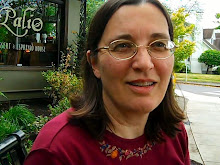
I've been assigned to read The Da Vinci Code for an upcoming writers' workshop. Fortunately, I've already read it and don't intend to inflict it on myself again.
But curious conjunctions bring out even curiouser connections.
The Code was in many ways exceedingly awful, but it managed to hold the attention and interest of many, many readers long enough to get them to recommend it to their friends. No book sells that many copies -- whatever the timeliness of the topic, the efficacy of the marketing, or the questionable taste of the readership -- without doing something right.
On further reflection, though, I noticed a characteristic it shares with a lot of paranoid conspiracy literature -- and others as well: a long explanation of What's Really Going On somewhere in the second act.
There was another Da Vinci Code knockoff whose name I can't remember, but the secret society was some other variety of gnostic, and it had a big sermon in the middle to explain to the reader What It's All About. My friend who has read Ayn Rand's Atlas Shrugged tells me that the hero gives a 60-page radio address in the middle of that book. In Foucault's Pendulum, my own favorite paranoid conspiracy book, there is massive explanation in the middle, though it's handled with a defter hand than some. And in a YA podcast I listened to recently, titled The Pocket and the Pendant, there is also a chapter of explanation before the climax.
These chunks of telling narrative are not info-dumps, per se, because although they're exposition, they're not introducing the story -- they're a means of pushing forward the "philosophical" aspect of the story. In every one of these books (well, I haven't read Atlas Shrugged, so I won't make a pronouncement on that one), you can skim or skip the sermon and not miss out on the plot -- theme maybe, "message" certainly. I wonder how many of the millions who read Da Vinci skipped the message.
What's so odd about all that?
Glad you asked.
This plot structure parallels the Divine Liturgy of the Eastern Orthodox Church (I've got to justify my "speculation" blog title occasionally).
The Liturgy already follows the general pattern of the Hero's Journey: At the beginning the priest announced the destination -- "Blessed is the Kingdom . . ." -- the Call to Adventure.
The three antiphons are processional -- the acceptance of the call and road of trials.
Troparia and kontakia and readings -- meeting of various mentors.
THE SERMON.
Anaphora -- belly of the whale.
Communion -- return with the boon.
Dismissal -- return to ordinary world with protagonist renewed and transformed.
In the Orthodox Church, it's possible to move or even dispense with the sermon. Some priests put it at the end -- in the narrative structure, it would be the equivalent of having a character explain the point at the end of the story. Or, like the fiction examples I named above, the sermon often goes into the second act, to give a sense of where the "story" is going in the middle of it.
I believe that the story described by the Hero's Journey and the other nomenclature (inciting incident, conflict, crisis, climax, resolution) is ingrained at the very core of our being, that it is our story -- personally, corporately, and throughout history. The Bible contains a cycle of Hero's Journeys -- pre-eminently the life and death of Christ -- in the form of an overarching Hero's Journey. Other mythologies as well. So it's no surprise that the Liturgy and best-sellers share this structure.
What's ironic is finding the element of the sermon in the best-sellers, especially those best-sellers, several of them being actively opposed to religion, others actively opposed to any religion that might express itself in a sermon.
But just as there's no way to escape having fundamental beliefs about how the universe is organized, there is also no way to escape an urge to explain how that organization ought to affect the here and now.

No comments:
Post a Comment